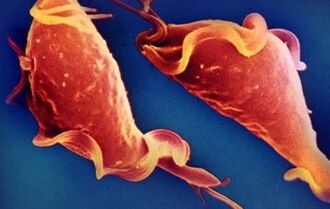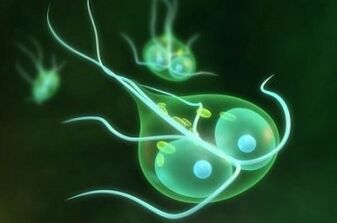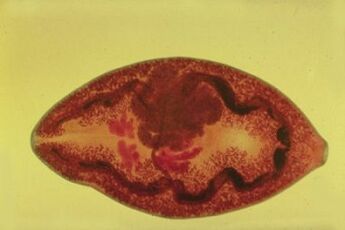Parasites often prevent a person’s normal life because they greatly weaken the body. What MPs most often parasitize on us, and how to treat them, the article says.
Parasites are living things that live and feed on their host. They can live in all animals, fish, birds, and humans. This causes a lot of problems because these creatures pretty much degrade health. Parasites in the human body can live in the liver, intestines, blood, and even attack the brain and lungs. What are the most common types? There are several different categories of parasites: flat and round worms, protozoa, and insects. How they affect the body and how to expel them - the article will tell you.
Types of parasites

As already mentioned, there are different types of parasites in the human body:
- protozoa (trypanosome, plasmodium malaria, lamblia, dysentery amoeba);
- flatworms (cat crisps, liver beetles, bovine and porcine tapeworms);
- globules (pinworm, pinworm);
- insects (lice, foxes, fleas);
- chelicerae (mites).
These species most often attack the human body. It unites all of them to feed on the juices and tissues of their master, killing them slowly. It’s hard to drive away any of them because they all have plenty of fastening devices (suckers, hooks, chelicerae) and there are even some that settle even in the cells of the body from which it’s simply impossible to drive them away.
Probably everyone knows about lice, fleas, and ticks because these creatures live on the surface of the body, are easy to find, and a little easier to fight. But not everyone knows the internal parasites of the body, and in fact these are the most dangerous to health.
The easiest
These small organizations can be found everywhere:
- in water;
- Earth;
- air.
It is impossible to see them because they consist of only one cell. There are harmless representatives: shiny shoes, proteus amoeba, green euglena and others. Some even help the animals, some the chilies digest the celluloses from the grass for the cows, but there are plenty of parasites among them.
Plasmodium malaria
<2_img_rxx>This Central African native has accompanied many countries today. Plasmodium malaria is carried by mosquitoes of the genus Anopheles, which are not very picky, the most important for them being heat and water. Several countries continued to prevent the disease: draining swamps, destroying larvae, and the disease retreated there, but this parasite is still rampant in the Central African and South American region.
Once in the body, malaria plasmodium goes through two stages: the liver and the erythrocyte. The first few hours will pass. Plasmodium attacks the liver cells, enters them, starts to multiply and feeds the host nutrients. At this time, a person is already experiencing the first unpleasant symptoms:
- headache;
- nausea;
- anorexia.
After a few days, the parasite leaves the liver in the bloodstream and settles in the red blood cells. He lives there for a long time. He leaves one every 3-4 days and enters the other. Exit involves the release of waste products from the protozoan, so the owner’s temperature rises rapidly and strongly, with fever, vomiting, and intestinal disorders starting.
Plasmodium malaria is difficult to treat because the parasite is hidden in the host cells. When the main symptoms of the disease appear, an ambulance should be called and the patient should be watered continuously before arrival because the temperature and fever will cause dehydration. One type of plasmodium is installed in the hospital (there are more than 5 of them) and treatment is prescribed.
Prevention is simple - find your habitat with a mosquito net if there are breeding grounds for the Anopheles mosquito in the district, and by draining swamps or flooding their surfaces with special tools that create a film through which mosquito larvae cannot breathe and die.
Giardia and amphibian amoeba

Both parasites live in the human digestive system and can be hosted by any animal. They penetrate the body along with dirty water, unwashed fruits or vegetables. My favorite places are the upper part of the liver, small intestine and colon.
Symptoms do not appear for long and are difficult not to notice. The first manifestations are stool disorders. Over time, the temperature rises suddenly, severe diarrhea and vomiting begin. Most often, a person dies from dehydration because the last two symptoms practically do not stop, the patient quickly loses water.
The fight against these parasites consists of drinking plenty of clean, boiled water and special salt packs - preparations containing preparations that contain a special salt preparation that help retain water in the body. Prevention is also simple - detergents, monitoring the condition of drinking water, because he is the source of the growth of these parasites.
Flat worms
Parasites in the human body can be unicellular or multicellular. These are flatworms. The name comes from their shape because they are really flat, because they breathe over the entire surface of the body, so they try to reduce the volume as much as possible. There are 3 types of flatworms: cilia, spots and tapeworms. The former are quite harmless, living in land or water. But the second two classes are exclusively parasites.
Suckers
These are small worms that have suckers on their mouths and bellies. Rather, they live in our body in the ducts of the liver and gallbladder. These helminths have two main life stages - a larva and an adult. The host of the larvae may be aquatic molluscs (liver fly), fish (cat bite), but cattle and humans are constant.

Adults most often settle in the liver, but can sometimes enter the intestines, lungs, or even the brain. Accompanied by their accommodation:
- headache;
- weight loss;
- anorexia;
- anemia.
They can only be killed by special anthelmintics that your doctor will prescribe depending on the type of parasite.
Prevention is simple: don’t drink water and try to swim in stagnant water, and don’t chew blades of grass in the field, as many like, because there may be larvae of flatworms on the grass.
Tape
Tapeworms are called because these parasites are long in length (except for the echinococcus), so they really look like a ribbon. They also evolve with a change in "residence, " but most often the person who is a permanent owner to them.
Bovine and porcine tapeworms attack the small intestine. They are secured with suction cups and hooks, so they cannot be taken out with feces. They are constantly growing, they can reach a length of 10 meters or more. They can only be driven out with special drugs that kill the parasite, the suckers relax, fall off and come out with feces.
One of the most dangerous representatives of tapeworms is echinococcus. The larva is hosted by humans and herbivores, the adult worm settles in predators. The larval state of the parasite is dangerous because it differs in structure from that of the tapeworm.
The echinococcus larva is a sac in which many larvae develop. Such a structure can attack the brain, lungs, intestines, liver. It is dangerous with its unlimited growth because sooner or later it simply tears off the owner’s tissues. If the echinococcus has hit the brain or lungs, only one surgery can save the patient, but it can also be dangerous.
If tapeworms have settled in our bodies, we urgently need to go to the hospital because they are constantly growing, clogging the intestines (tapeworms), touching the lungs or brain (echinococcus), eating all the vital juices and killing their host. . Prevention consists in checking meat and fish for white or yellowish larvae. If there are any, you should never eat such a product!
Round worms

Many have also heard of round worms because they poison people’s lives no less often than flat ones, especially young children. The most famous representatives are roundworms and pinworms that live in human intestines. Sometimes they can get to other organs: liver, eyes, brain.
Roundworms develop as habitat changes: larvae live in a person's lungs and adults live in the intestines. The name "round" characterizes their cross section - they are really wheels.
These worms do not have fixation devices, but they do have muscles that help resist stool. Sometimes they themselves climb out of the body (pinworm) and lay eggs on the anus.
Children suffer from them because babies are unfamiliar with the rules of hygiene, so by combing the place where the eggs are deposited, they can pull their fingers into their mouths and become re-infected.
Treatment is possible with medications prescribed by your doctor. If the mother of the pinworm baby is half afraid to give her pills, she can cure it without it. This requires 5-6 o'clock in the morning (at which point the female leaves the body and lays eggs around the anus) to wipe the inside of the priests with vodka and then lubricate the treatment site. baby cream so as not to dry out delicate skin.
Prevention consists of constant monitoring of hygiene: wash hands after touching the ground, do not drink dirty water.
Parasite test
If you have doubts about your own health, you can test for the presence of parasites in your body. If any of the following symptoms exist, add a plus sign.
- Weight loss can be observed without diets or dietary changes.
- The temperature is constantly rising, from 37 to 37, around 5 grams.
- There is no appetite or, on the contrary, he wants to eat constantly.
- He often longs to eat something sweet.
- Increased headache.
- Hot flashes of weakness.
- Stool disorders.
- Nausea or vomiting
- Allergic rash or swelling.
- Pain in the liver and intestines.
- Fainting (if the brain is affected).
- Shaking hands.
- Persistent pallor.
If there are 1-4 plus, it means there are no worms, but the person is under constant stress, is sick or has problems with the digestive system. If there are 5-7 plus, the presence of parasites can be assumed, but more than 8 positive responses indicate real problems, so a doctor should be consulted urgently.
Parasites poison the human body, weaken the immune system, prevent them from living a normal active life, so you need to remember the symptoms of their manifestation and treatment methods, as well as preventative measures, because only then can you protect yourself and your family.
























